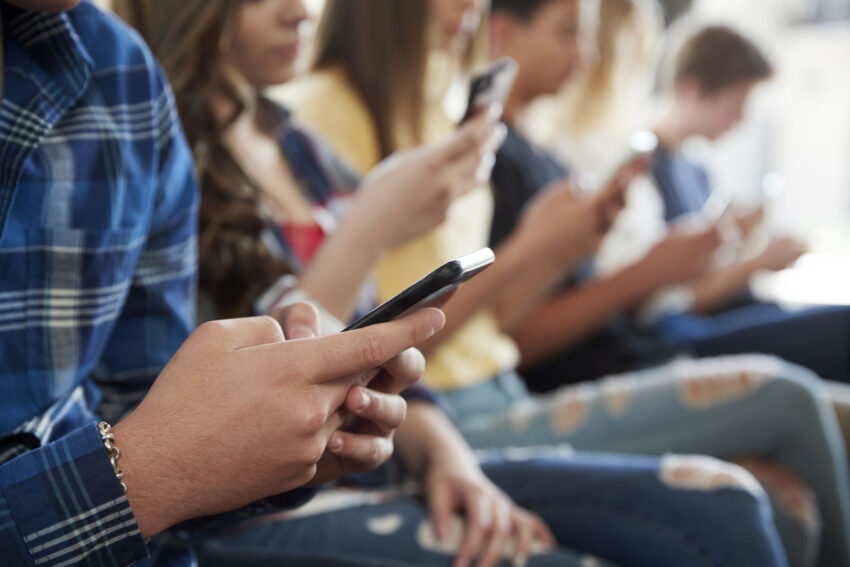
Share On Social!
35% of U.S. teens say they are using at least one of YouTube, TikTok, Instagram, Snapchat, and Facebook “almost constantly,” according to Pew Research Center.
How does social media impact adolescent health?
There are complex benefits and harms, according to a new report that tackles the effects of social media on children and adolescents’ physical and mental health, from the National Academies of Sciences, Engineering, and Medicine (NASEM).
This is important for Latinos, 98% of whom own a smartphone and who are the highest-percentage users of Facebook, Instagram, Tik Tok, and WhatsApp among racial/ethnic groups.
“The use of social media—rather than having purely negative or positive impacts—is likely a constantly shifting calculus of the risky, the beneficial, and the mundane that affects different people in different ways,” according to the NASEM report.
Benefits and Harms of Social Media
Social media are the interactive technologies that facilitate the creation and sharing of information, ideas, interests, and other forms of expression through virtual communities and networks, including social networking, gaming, virtual worlds, video sharing sites, and blogs, according to the NASEM report.
The report highlights the pros and cons of social media use of adolescence.
“Contrary to the current cultural narrative that social media is universally harmful to adolescents, the reality is more complicated,” according to the report overview.
On one hand, social media can connect adolescents to friends, families, and supportive and safe communities.
It also can provide educational and creative resources that can support young people’s hobbies and interests.
On the other hand, social media can also encourage harmful comparisons and can impact healthy and essential habits like sleep, exercise, studying, or social activities.
NASEM highlights signs of problematic use, including heightened intensity of emotions and disengagement from friends, schoolwork, or hobbies.
“The differences between an adolescent brain and adult brain also mean that teenagers can be uniquely affected by social media use,” according to a press release. “Adolescents have less-developed controls for regulating emotions, have heightened sensitivity to rewards, and are meant to seek out independence and explore new identities during this specific time of their maturation.”
Understanding the Impact of Social Media
The NASEM report identifies how quantifying the relationship between social media and health is challenging, like:
- Pinpointing the direction of impact is complicated (i.e., social media use may influence health as often as health influences social media use);
- Current research approaches are not uniform;
- Understanding the relationship between an exposure (social media use) and a health outcome when the exposure is almost constant is challenging; and
- Social media use is not the same for everyone.
“Despite widespread concern about social media’s effects, it is hard to offer an overall summary of the relationship between social media and mental health beyond observing that the effects, both helpful and harmful, accrue differently to different users,” according to the NASEM report.
The NASEM reports that more research is necessary to inform current and future policy and decision making about social media use and health.
NASEM also recommends a research agenda that prioritizes the investigation of topics like health consequences of social media use, role of parents and other adults in influencing positive use, and establishing long-term cohort studies, among other recommendations.
Recommendations Moving Forward
For a better understanding of social media’s influence on development, the NASEM report makes specific recommendations for policymakers and other leaders.

The recommendations focus on four main categories:
- Design (greater accountability and putting transparency into practice)
- Training and education (comprehensive digital media literacy education and integrating digital media competency into professional education)
- Online harassment (cyberbullying, sexual offenses, and support for victims and momentum for prosecution)
- Research (research agenda and encouraging the use of real-world data)
“More research is necessary to inform current and future policy and decision making about social media use and health,” according to the NASEM report summary.
The complete report can be found here.
Additional information and resources regarding the report can be found here.
How to Use Your Phone in Healthy Ways
96% of U.S. Latino teens and 95% of all teens have access to a smartphone, and about half are online “almost constantly.”
What are ways individuals can practice healthy habits when using social media?
Check out “5 Ways to Practice Healthy Social Media Habits.”
“It’s clear the social media will continue to play a large part of people’s everyday lives. It’s up to the individual to monitor how much they scroll through,” according to a Salud America! resource.
You can also download the Salud America! Health Equity Report Card.
The Report Card explores local data, maps, and gauges several factors including:
- Physical and Mental Health
- Education
- Healthcare access
The report card allows you to explore maps, data, and gauges to compare your local health equity issues to the rest of your state and nation.
Then email your report card to local leaders and share it on social media to raise awareness and action for change!
GET YOUR HEALTH EQUITY REPORT CARD!
Explore More:
Healthy Families & SchoolsBy The Numbers
142
Percent
Expected rise in Latino cancer cases in coming years



